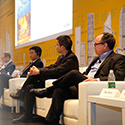Filter by
You must be a CTBUH Member to view this resource.
Shun Hing Square
Di Wang Commercial Centre
Building
Completed, 1996
518001
office
composite
384.0 m / 1,260 ft
69
3
900
36
5 m/s
280,000 m² / 3,013,895 ft²
You must be a CTBUH Member to view this resource.
You must be a CTBUH Member to view this resource.
The Peer Review Engineer traditionally comments on the information produced by another party, and to render second opinions, but not to initiate what the design looks like from the start.
Other Consultant refers to other organizations which provided significant consultation services for a building project (e.g. wind consultants, environmental consultants, fire and life safety consultants, etc).
Material Supplier refers to organizations which supplied significant systems/materials for a building project (e.g. elevator suppliers, facade suppliers, etc).
You must be a CTBUH Member to view this resource.
Usually involved in the front end design, with a "typical" condition being that of a leadership role through either Schematic Design or Design Development, and then a monitoring role through the CD and CA phases.
The Design Engineer is usually involved in the front end design, typically taking the leadership role in the Schematic Design and Design Development, and then a monitoring role through the CD and CA phases.
The Peer Review Engineer traditionally comments on the information produced by another party, and to render second opinions, but not to initiate what the design looks like from the start.
The Design Engineer is usually involved in the front end design, typically taking the leadership role in the Schematic Design and Design Development, and then a monitoring role through the CD and CA phases.
The main contractor is the supervisory contractor of all construction work on a project, management of sub-contractors and vendors, etc. May be referred to as "Construction Manager," however, for consistency CTBUH uses the term "Main Contractor" exclusively.
Other Consultant refers to other organizations which provided significant consultation services for a building project (e.g. wind consultants, environmental consultants, fire and life safety consultants, etc).
Material Supplier refers to organizations which supplied significant systems/materials for a building project (e.g. elevator suppliers, facade suppliers, etc).
Top Company Rankings: The World’s 100 Tallest Buildings
13 October 2016 - CTBUH Research
CITAB-CTBUH Name 2016 China Tall Building Award Recipients
25 February 2016 - CTBUH News

18 October 2016 | Shenzhen
Urban Development and Tall Buildings in Shenzhen
Tuesday October 18, 2016. Shenzhen, China. Chongguang Xu of Shenzhen Municipal Government, presents at the 2016 China Conference Session 7b: Shenzhen Bay Development. This presentation...
Shun Hing Square, which is also known as the Diwang Building, is built on a triangular site on Shenzhen’s main east-west corridor, Shennan Road, and is a key feature of the area known as Shenzhen’s Special Economic Zone. The tower and its nearby annex, which share a variety of visual cues, are juxtaposed in a “T” formation to accommodate mutual sightlines. The main tower holds 144,200 square meters of Grade A office space, while the accompanying 35-floor annex contains 330 high-end apartments, a parking garage, and a five-story shopping arcade podium. The wedge-shaped annex building holds a swimming pool in a 22-meter-wide opening between the towers, allowing sunlight in to brighten the façade.
The main tower was built at the incredible rate of four floors every nine days, taking just 40 months to complete from start to finish. The tower’s form resembles a pair of syringes, with distinctive rooftop lasers that give off striking beams of colored light at night. From a distance, the building’s skin appears to have simple horizontal and vertical patterns; however, upon closer inspection, smaller accents of varying color and material add a touch of complexity to the exterior. The building’s color palette includes earthen tones of natural browns and striking green glass. Shun Hing Square boasts an impressive observation deck at the 69th floor, called the Meridian View Centre, which affords exceptional views of the city.
A rectangular tower plan was implemented to accommodate an assortment of 328-square-meter office spaces. The design also strove to encompass the maximum fire compartment size per floor. This special consideration resulted in a structure with a height to width ratio of 1:8, an extraordinary feat in this typhoon and earthquake design zone, where buildings are typically subjected to intense overturning forces.

18 October 2016 | Shenzhen
Urban Development and Tall Buildings in Shenzhen
Tuesday October 18, 2016. Shenzhen, China. Chongguang Xu of Shenzhen Municipal Government, presents at the 2016 China Conference Session 7b: Shenzhen Bay Development. This presentation...

17 October 2016 | Shenzhen
Panel Discussion: Future Cities: What are the Biggest Threats and Opportunities?
Monday, October 17, 2016. Shenzhen, China. A panel discussing the challenges of growing urban populations throughout the globe.
13 October 2016
The Council is pleased to announce the Top Company Rankings for numerous disciplines as derived from the list of projects appearing in 100 of the World’s Tallest Buildings.
Subscribe below to receive periodic updates from CTBUH on the latest Tall Building and Urban news and CTBUH initiatives, including our monthly newsletter. Fields with a red asterisk (*) next to them are required.
View our privacy policy